Practice Free AZ-305 Exam Online Questions
HOTSPOT
You have two on-premises Microsoft SQL Server 2017 instances that host an Always On availability group named AG1. AG1 contains a single database named DB1.
You have an Azure subscription that contains a virtual machine named VM1VM1 runs Linux and contains a SQL Server 2019 instance.
You need to migrate DB1 to VMI. The solution must minimize downtime on DBI.
What should you do? To answer, select the appropriate options in the answer area. NOTE: Each correct selection is worth one point.


DRAG DROP
You are designing a virtual machine that will run Microsoft SQL Server and will contain two data disks. The first data disk will store log files, and the second data disk will store data. Both disks are P40 managed disks.
You need to recommend a caching policy for each disk. The policy must provide the best overall performance for the virtual machine.
Which caching policy should you recommend for each disk? To answer, drag the appropriate policies to the correct disks. Each policy may be used once, more than once, or not at all. You may need to drag the split bar between panes or scroll to view content. NOTE: Each correct selection is worth one point.


Explanation:
Reference: https://docs.microsoft.com/en-us/azure/virtual-machines/windows/sql/virtual-machines-windows-sql-performance
You need to recommend a strategy for migrating the database content of WebApp1 to Azure.
What should you include in the recommendation?
- A . Use Azure Site Recovery to replicate the SQL servers to Azure.
- B . Use SQL Server transactional replication.
- C . Copy the BACPAC file that contains the Azure SQL database file to Azure Blob storage.
- D . Copy the VHD that contains the Azure SQL database files to Azure Blob storage
B
Explanation:
Before you upload a Windows virtual machine (VM) from on-premises to Azure, you must prepare the virtual hard disk (VHD or VHDX).
Scenario: WebApp1 has a web tier that uses Microsoft Internet Information Services (IIS) and a database tier that runs Microsoft SQL Server 2016. The web tier and the database tier are deployed to virtual machines that run on Hyper-V.
Reference: https://docs.microsoft.com/en-us/azure/virtual-machines/windows/prepare-for-upload-vhd-image
HOTSPOT
You are designing a data storage solution to support reporting.
The solution will ingest high volumes of data in the JSON format by using Azure Event Hubs. As the data arrives, Event Hubs will write the data to storage.
The solution must meet the following requirements:
• Organize data in directories by date and time.
• Allow stored data to be queried directly, transformed into summarized tables, and then stored in a data warehouse.
• Ensure that the data warehouse can store 50 TB of relational data and support between 200 and 300 concurrent read operations.
Which service should you recommend for each type of data store? To answer, select the appropriate options in the answer area. NOTE: Each correct selection is worth one point.
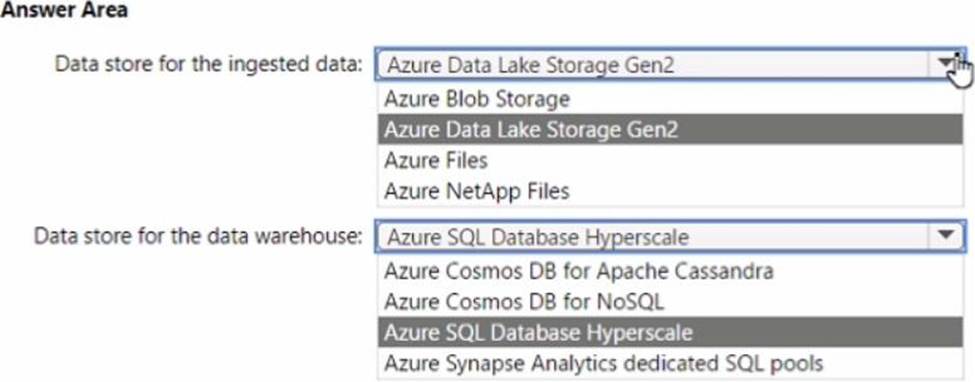
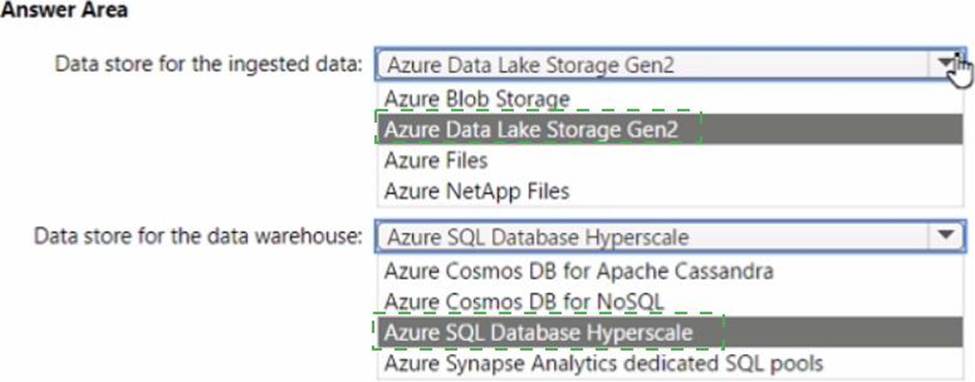
Your company has an app named App1 that uses data from the on-premises Microsoft SQL Server databases shown in the following table.
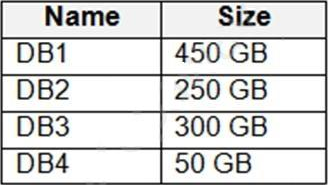
App1 and the data are used on the first day of the month only. The data is not expected to grow more than 3% each year.
The company is rewriting App1 as an Azure web app and plans to migrate all the data to Azure.
You need to migrate the data to Azure SQL Database. The solution must minimize costs.
Which service tier should you use?
- A . vCore-based Business Critical
- B . vCore-based General Purpose
- C . DTU-based Standard
- D . DTU-based Basic
B
Explanation:
DTU-based Standard supports databases up to 1 TB in size.
Reference: https://docs.microsoft.com/en-us/azure/azure-sql/database/service-tiers-dtu
You have an Azure subscription that contains an Azure Blob storage account named store1.
You have an on-premises file server named Setver1 that runs Windows Sewer 2016. Server1 stores 500 GB of company files.
You need to store a copy of the company files from Server 1 in store1.
Which two possible Azure services achieve this goal? Each correct answer presents a complete solution. NOTE: Each correct selection is worth one point
- A . an Azure Batch account
- B . an integration account
- C . an On-premises data gateway
- D . an Azure Import/Export job
- E . Azure Data factory
D, E
Explanation:
https://docs.microsoft.com/en-us/azure/storage/common/storage-import-export-data-from-blobs
https://docs.microsoft.com/en-us/answers/questions/31113/fastest-method-to-copy-500gb-table-from-on-premise.html
DRAG DROP
You have an on-premises named App 1.
Customers App1 to manage digital images.
You plan to migrate App1 to Azure.
You need to recommend a data storage solution for Appl.
The solution must meet the following image storage requirements:
✑ Encrypt images at rest.
✑ Allow files up to 50M
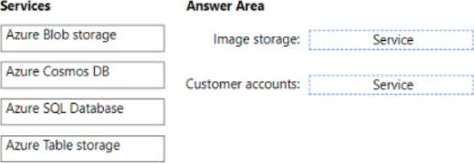
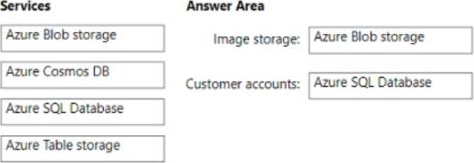
HOTSPOT
You deploy several Azure SQL Database instances.
You plan to configure the Diagnostics settings on the databases as shown in the following exhibit.
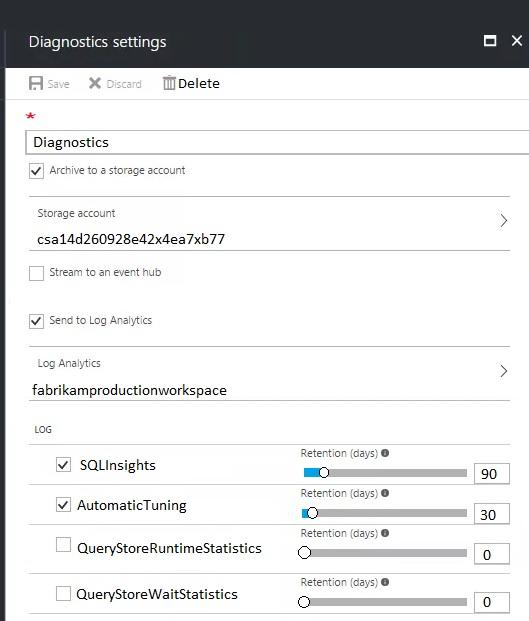
Use the drop-down menus to select the answer choice that completes each statement based on the information presented in the graphic. NOTE: Each correct selection is worth one point.
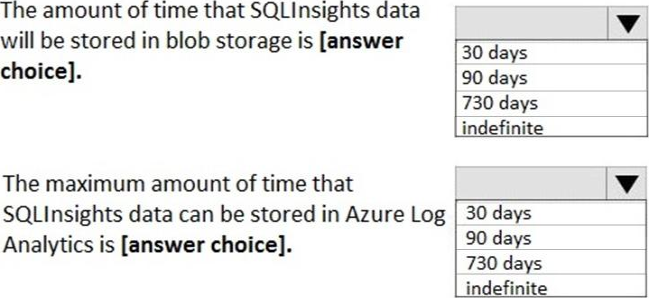

Explanation:
In the exhibit, the SQLInsights data is configured to be stored in Azure Log Analytics for 90 days. However, the question is asking for the “maximum” amount of time that the data can be stored which is 730 days.
You have an Azure App Service app named App1.
You need to recommend a solution to monitor the response times of App1 for end users. The solution must minimize administrative effort.
What should you include in the recommendation?
- A . Health check in App Service
- B . Log Analytics
- C . Application Insights
- D . Azure Network Watcher connection monitor
Your company currently has an application that is hosted on their on-premises environment. The application currently connects to two databases in the on-premises environment. The databases are named whizlabdb1 and whizlabdb2.
You have to move the databases onto Azure. The databases have to support server-side transactions across both of the databases.
Solution: You decide to deploy the databases to an Azure SQL database-managed instance.
Would this fulfill the requirement?
- A . Yes
- B . No
